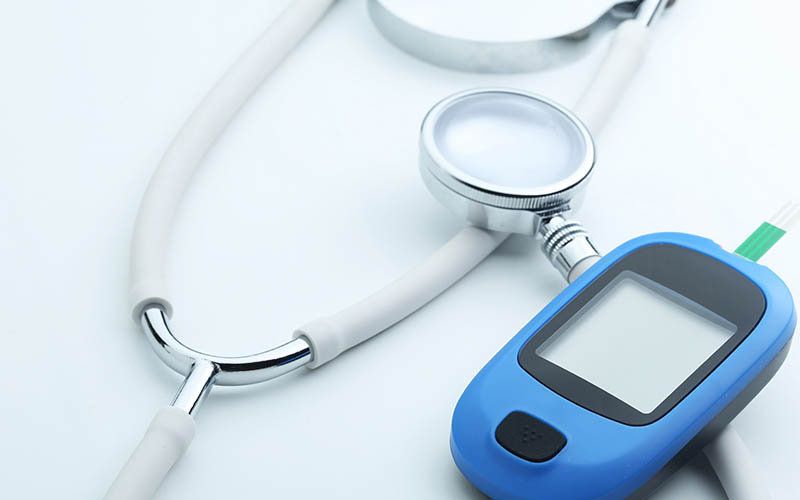Diabetes is defined as a metabolic disorder that requires continuous medical care, in which the organism cannot make use of carbohydrates, fats and proteins sufficiently due to insulin hormone deficiency or deterioration in the effect of insulin. The hormone insulin carries glucose in the blood to body cells for storage or use for energy. The body of individuals with diabetes cannot secrete enough insulin or cannot effectively use the insulin it produces.
A range of 70-100 mg/do of glucose in fasting blood sugar is considered normal in healthy individuals. The first medical intervention for the diagnosis of diabetes is usually fasting blood glucose (FGG) measurement or Oral Glucose Tolerance Test (OGTT). If the fasting blood glucose measurement result is in the range of 100-125 mg/dl (pre-diabetes), it indicates the presence of latent diabetes, and 126 mg/dl and above indicates the presence of diabetes. At the end of the 2nd hour after OGTT glucose load, if blood glucose is between 140-199 mg/dl, pre-diabetes is diagnosed, and if it is 200 mg/dl or more, diabetes is diagnosed.
In individuals due to high blood glucose; such as polyuria (frequent urination), polydipsia (excessive thirst), polyphagia (overeating), nocturia (frequent urination at night), numbness and pain in the hands and feet, delayed healing of wounds, dry and itchy skin, blurred vision, frequent infections. Many symptoms are seen.
Article Content
Types of Diabetes

1) Type 1 Diabetes
It is an insulin deficiency that occurs as a result of autoimmune damage to the β cells in the pancreas that occurs in the body’s own defense system and secretes insulin. There is an absolute need for insulin as the body cannot secrete enough insulin hormones. In people with type 1 diabetes, the pancreas cannot produce enough insulin. Due to the lack of insulin, circulating glucose cannot enter the cell and cannot be converted into the necessary energy. The inability of glucose to enter the cell causes blood sugar to rise and is filtered through the kidneys and excreted in the urine. The presence of glucose in the urine causes fluid loss. Typical symptoms of diabetes appear, such as fatigue and fatigue. Although it can occur at any age, it is often observed in people under the age of 30. Genetic factors play a major role in the development of the disease.
2) Type 2 Diabetes
It is one of the most common types of diabetes. Although type 2 diabetes is known as diabetes in adults, there is an increase in childhood type-2 diabetes today. In individuals with type 2 diabetes, the body becomes resistant to insulin and the insulin hormone cannot be used efficiently. This results in the pancreas trying to produce more insulin. Over time, the cells in the pancreas are damaged and insulin secretion is impaired. A sedentary lifestyle and excessive food intake trigger obesity, obesity causes insulin resistance, and as a result, diabetes emerges as an inevitable result. Weight loss, an adequate and balanced diet, blood sugar regulation and exercise can help keep this disease under control.
3) Gestational Diabetes
Gestational diabetes (gestational diabetes) is high blood sugar that develops with insulin resistance that occurs after the 24th week of pregnancy and poses a risk for the development of type 2 diabetes after pregnancy. Gestational Diabetes is one of the most common problems in pregnancy. Gestational diabetes occurs in approximately 10% of pregnancies. In all pregnant women 24-28 weeks of pregnancy. A sugar loading test should be done between the weeks of Diabetes in the family, insufficient physical activity, obesity, high blood pressure are risk factors for gestational diabetes.
Nutritional Therapy in Diabetes

Nutritional therapy of diabetes is an indispensable component of treatment in the prevention and treatment of prediabetes, diabetes and its complications. The American Dietetic Association recommends that people with type 1 and type 2 diabetes consult a dietitian within the first month after diagnosis and patients with Gestational Diabetes within the first week following the diagnosis.
With an effective nutritional therapy, it provides weight loss and improvement in blood glucose level, blood pressure and blood lipid levels in patients. Studies have shown that nutritional therapy reduces HbA1c in type 1 and type 2 diabetes patients, and a 1% reduction in HbA1c provides a reduction in diabetes-related complications.
A personalized nutrition program is the basis of treatment for diabetics to lead a healthy and high-quality lifestyle. A good nutrition plan, especially for those with Type II diabetes, is important to keep their blood glucose levels at normal levels.
45-60% of the energy requirement can be met from CHs, 10-20% from proteins and 20-35% from fats. Providing <30% of energy from fats, <7% from saturated fats and <1% trans fat intake are effective in preventing cardiovascular diseases.
Carbohydrates: The type and amount of carbohydrates should be adjusted according to dietary habits, targeted blood glucose and lipid levels. Diets with carbohydrates below 130g/day are not recommended. Approximately 45%-55% of the total daily calories should be provided from carbohydrates. The glycemic index and glycemic load of carbohydrates are as important as the amount of carbohydrates taken.
Foods recommended as a carbohydrate source for individuals with diabetes; whole grain cereals, bread, legumes, vegetables, fruits, milk and dairy products. Instead of processed white flour, complex carbohydrates such as high fiber, unrefined, whole wheat bread, whole wheat rice, pasta should be preferred. Whole grains are rich in fiber, vitamins and minerals.
Fiber: Dietary fiber is one of the food components that are resistant to digestive enzymes. Indigestible pulp is used by beneficial bacteria in the intestines and has very positive effects on intestinal health. Dietary fiber slows the absorption of carbohydrates, preventing the rapid rise of blood glucose. It prevents the rise of blood fats. Fruits, vegetables, whole grains and legumes are foods rich in fiber. The recommended amount of fiber per day is 25-35 grams.
Fruits and vegetables are very rich food items in terms of fiber, vitamins, minerals and antioxidants. Consuming the fruit itself instead of the juice of the fruit enables the use of the pulp of the fruit. Having a protein or fat group food next to the fruit consumed between meals helps in better management of blood sugar regulation. Vegetables are high in fiber and water, so they make you feel fuller with fewer calories.
Fat and cholesterol: It is necessary to reduce the intake of saturated fat, cholesterol and trans fat in order to reduce the risk of cardiovascular disease, reduce triglyceride and cholesterol levels, and prevent the decrease of HDL cholesterol. Including monounsaturated and polyunsaturated fats in the diet, called ‘healthy fats’, can help lower cholesterol levels. Nuts such as olive oil, avocado, hazelnut, peanut, walnut can be added to the diet. In addition, fish rich in omega-3 fatty acids such as salmon, sea bass and mackerel should be included in the diet.
Meal Planning

Irregular food intake of individuals with diabetes leads to hypoglycemia and hyperglycemia. By distributing the nutrients throughout the day, insulin production becomes more appropriate and the need for insulin is reduced. Eating with at least 5 meals and not exceeding 3-4 hours between meals helps to prevent sudden increases or decreases in blood glucose levels.
The Relationship between Diabetes and Obesity
The prevalence of type 2 diabetes is three times higher in obese individuals than in non-obese individuals. High blood fats in the body reduce the effect of insulin hormone and create resistance to insulin. Depending on this resistance, various disorders occur in insulin production. All these disorders lead to hyperglycemia, impaired glucose tolerance and the development of type-2 diabetes. For this reason, providing weight control has an important place in preventing diabetes and other chronic diseases.
Diabetes and Physical Activity
Physical activity, as well as nutrition and drug use, has a protective effect on blood glucose control in diabetes. Physical activity accelerates the use of glucose by cells after it is absorbed into the blood, which is formed as a result of the breakdown of nutrients. Thus, a decrease in blood glucose levels is achieved. Physical activity has an important place especially in body weight control. Body weight is kept at an ideal level with physical activity. It reduces the need for drugs. It reduces cholesterol and triglycerides, raises HDL cholesterol (good cholesterol), and lowers LDL cholesterol (bad cholesterol). It helps to improve and maintain lung health.
 AR
AR

